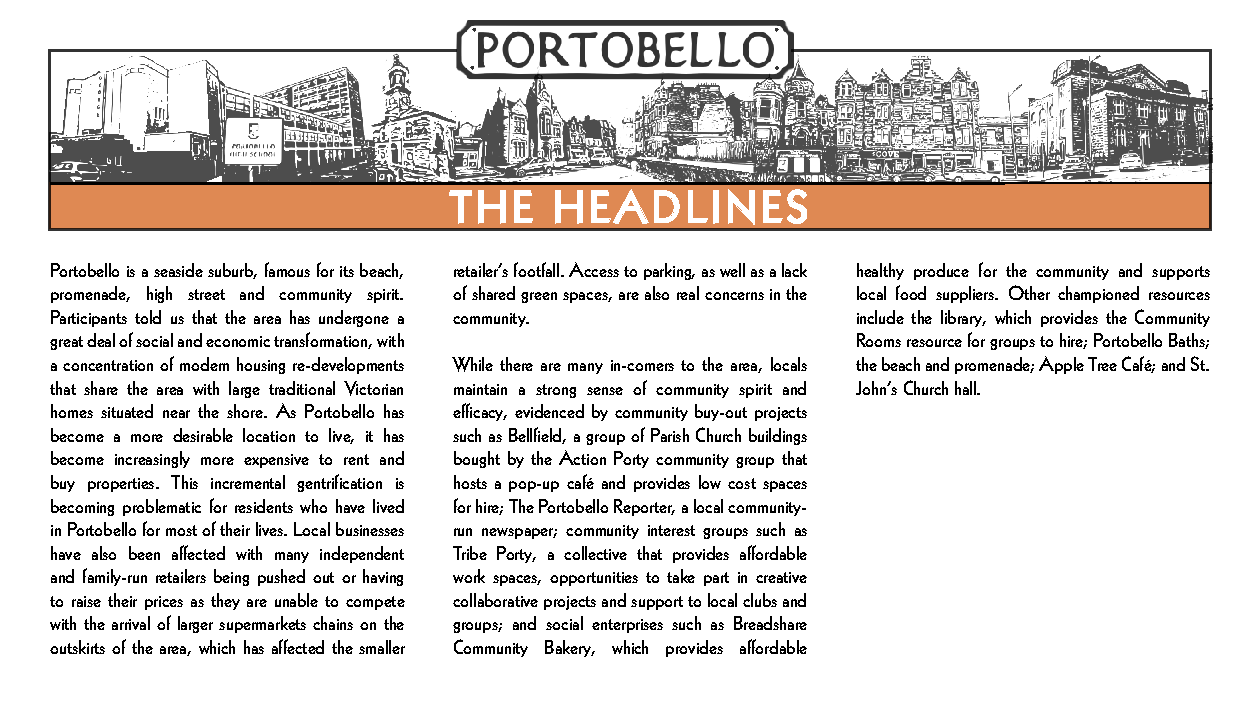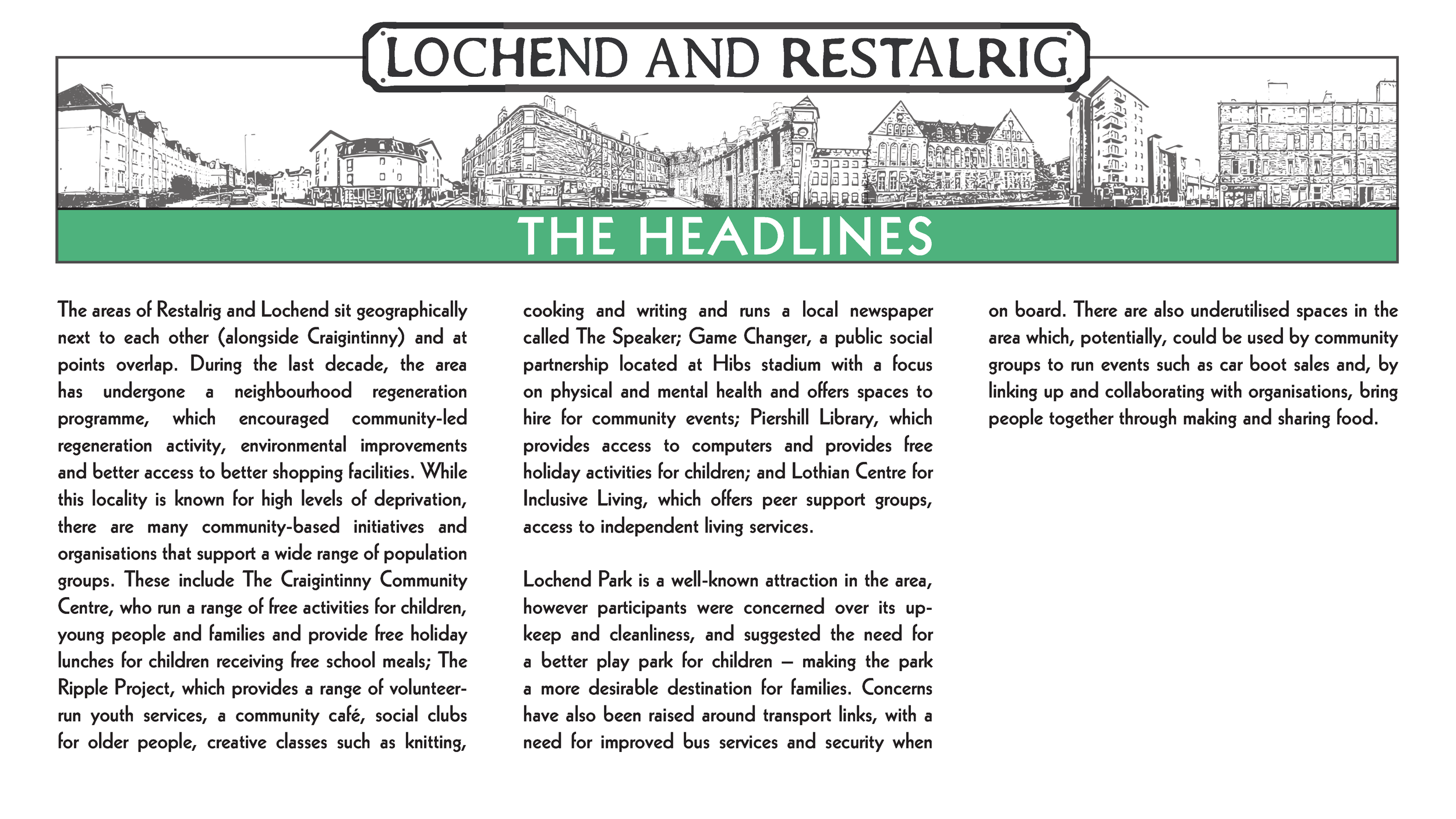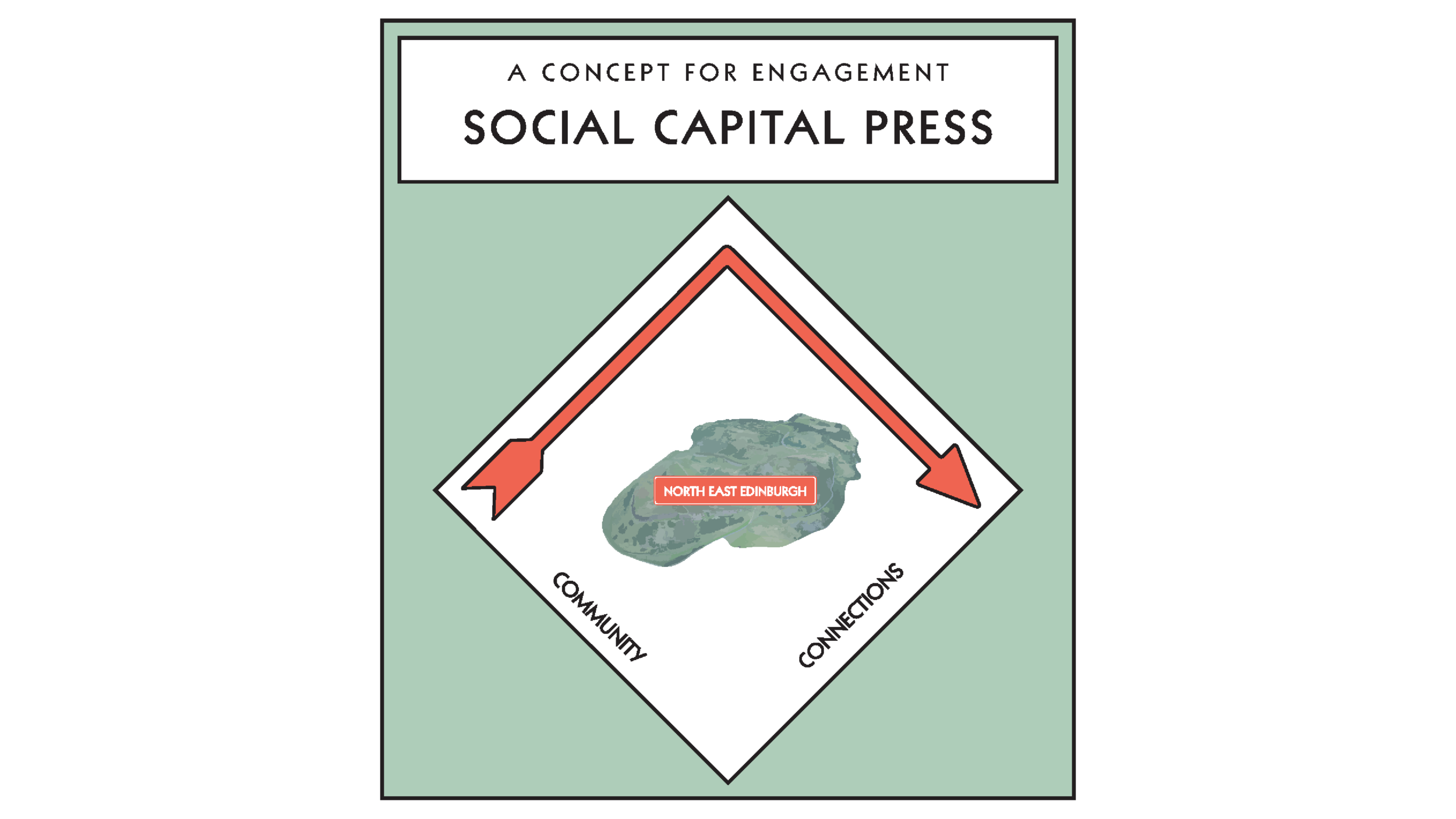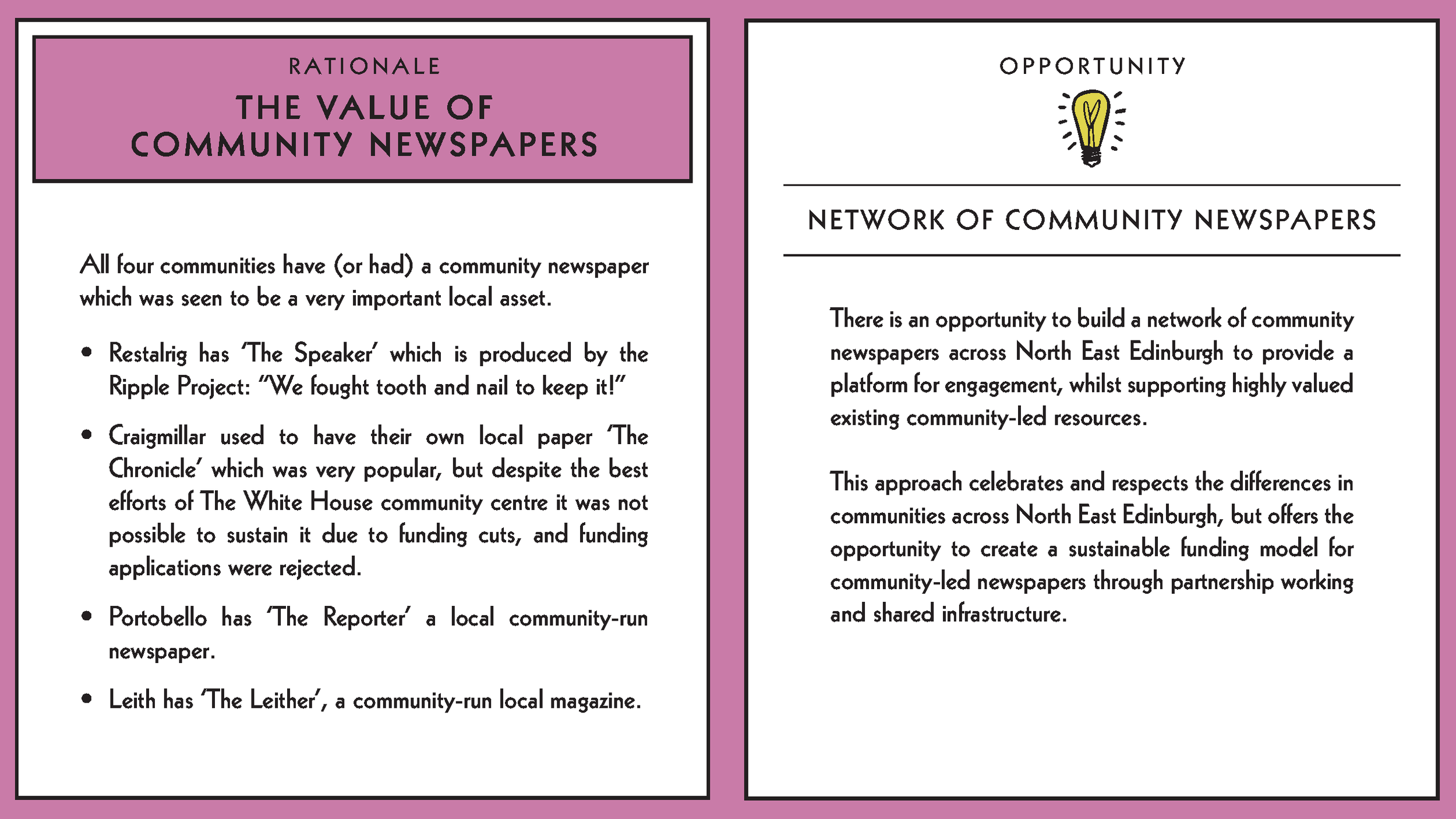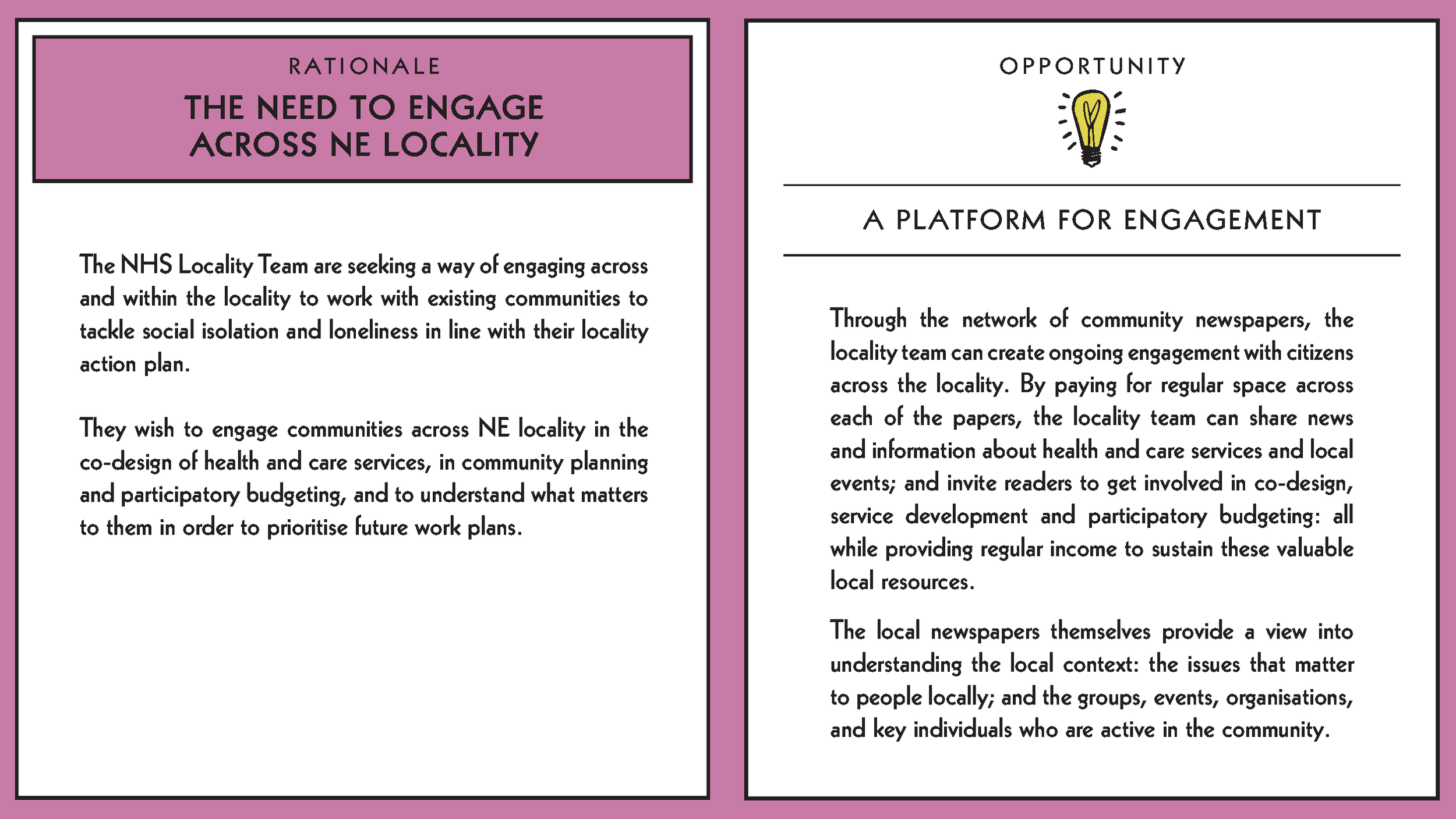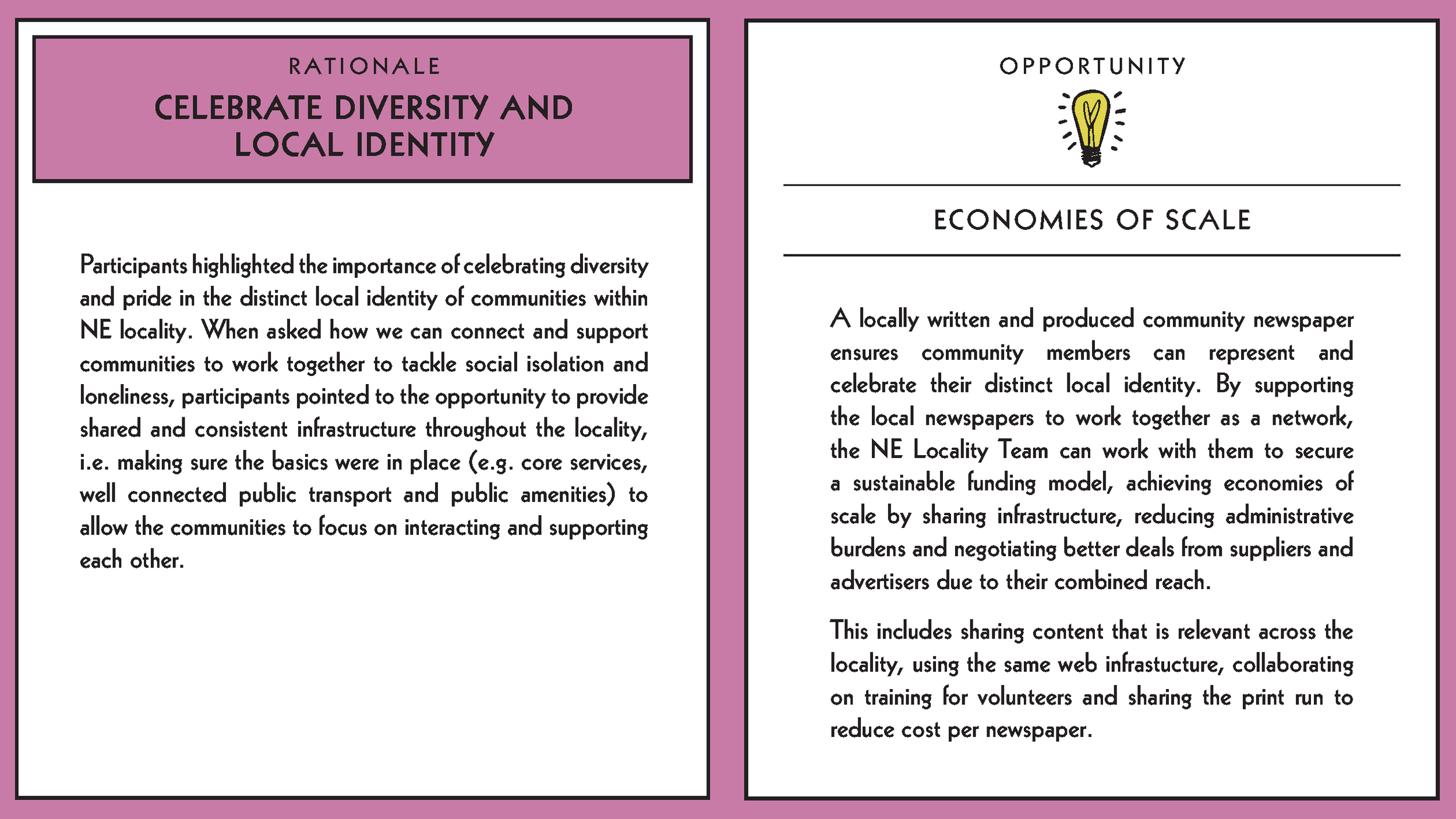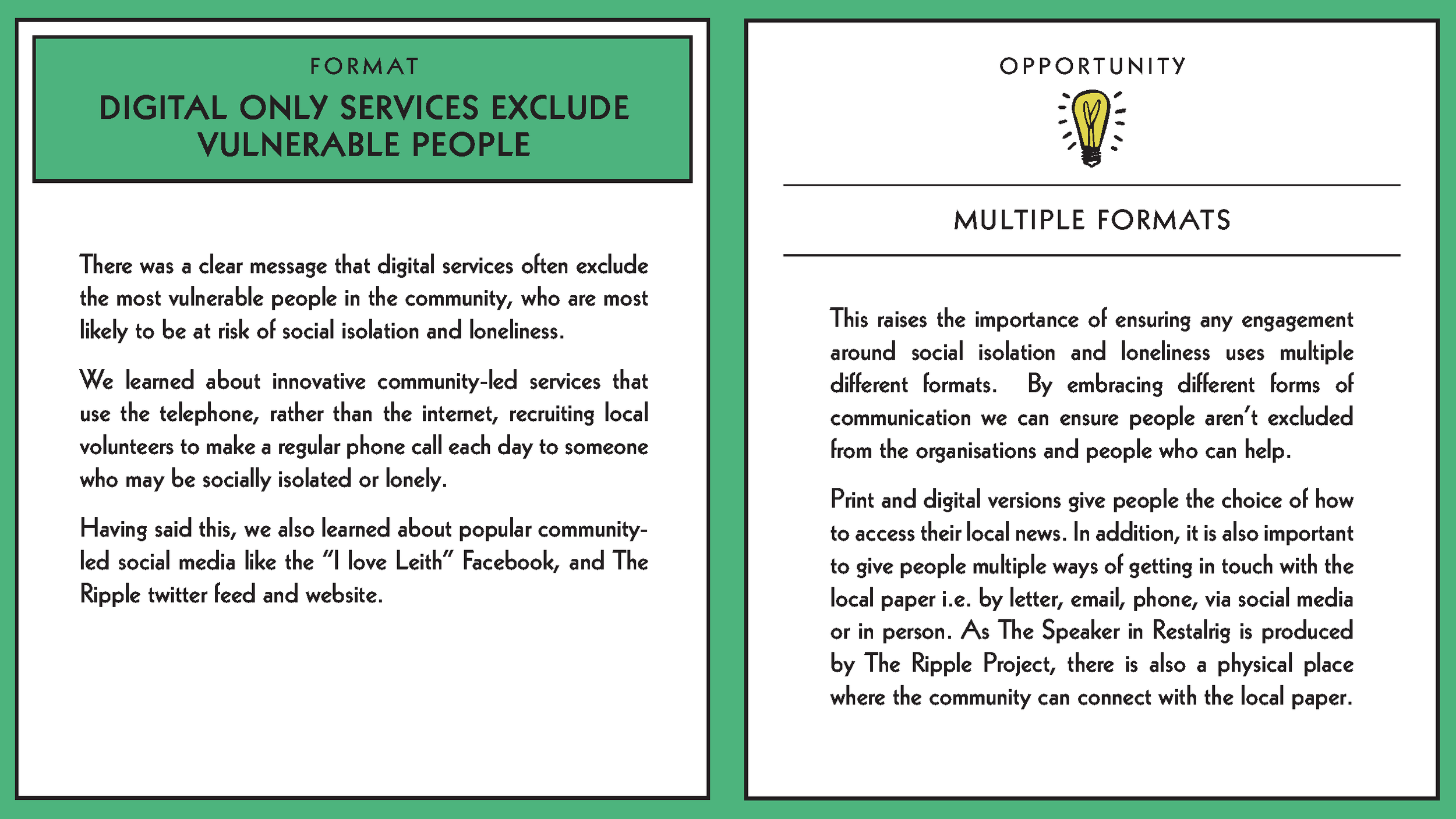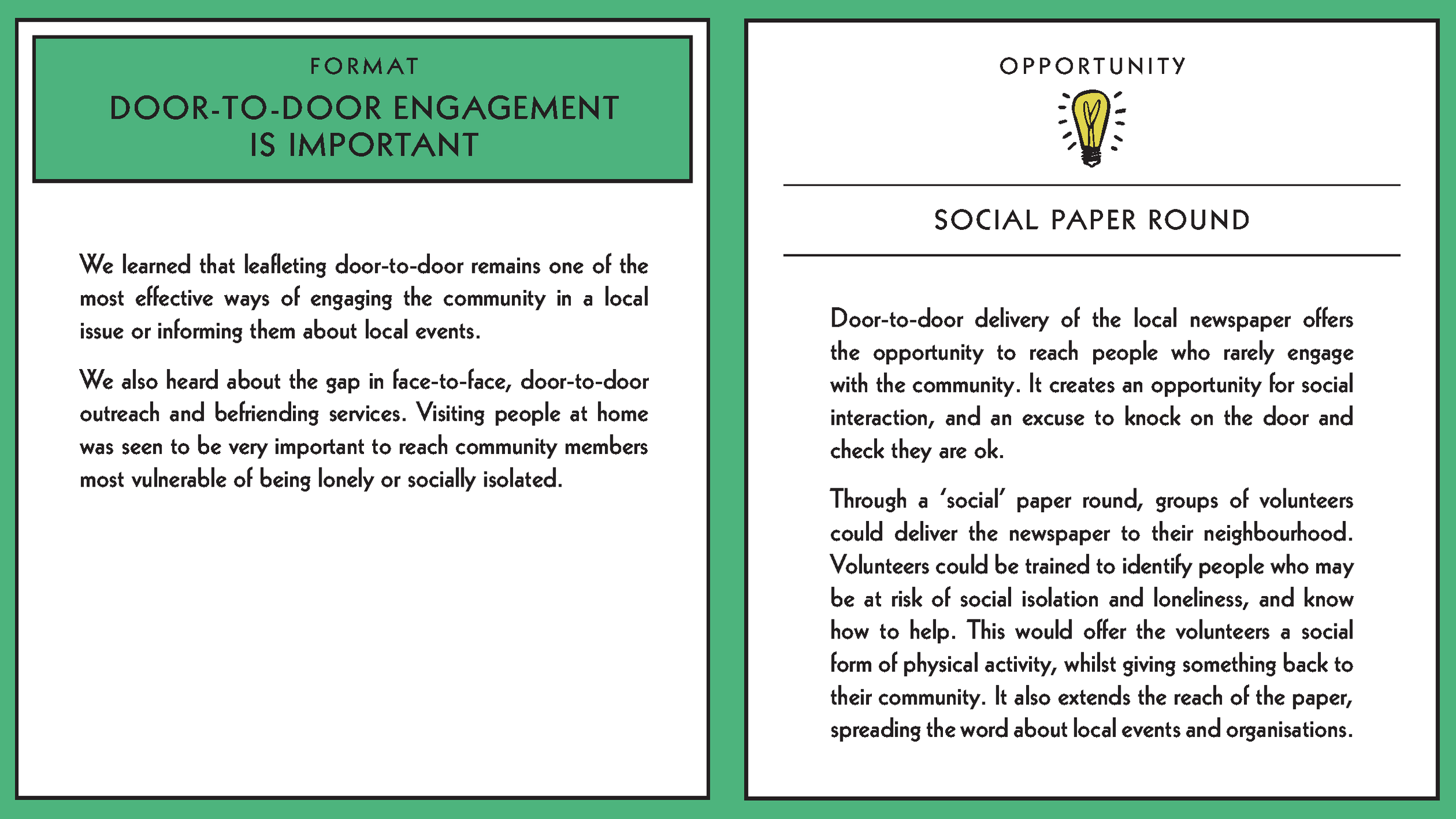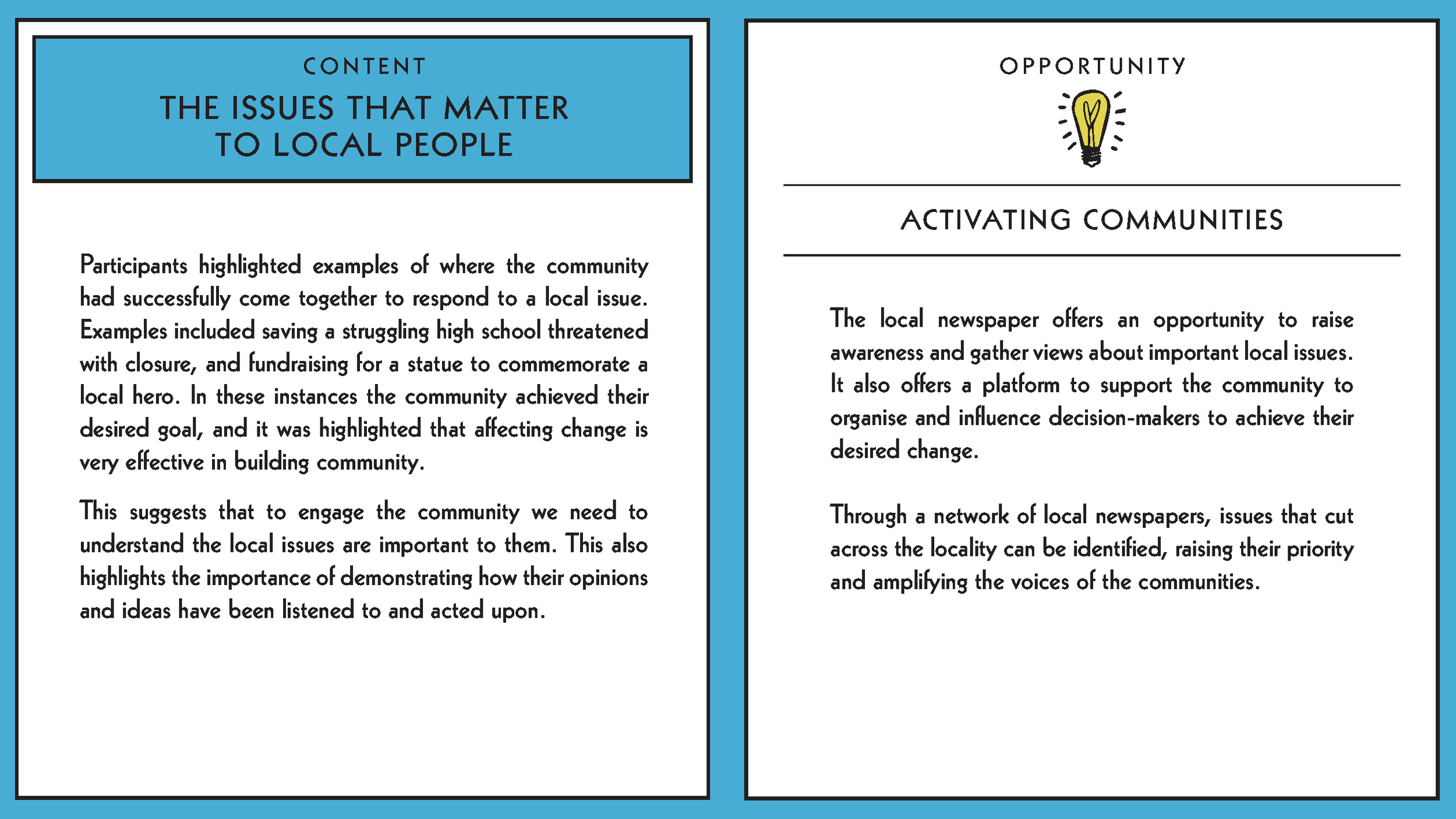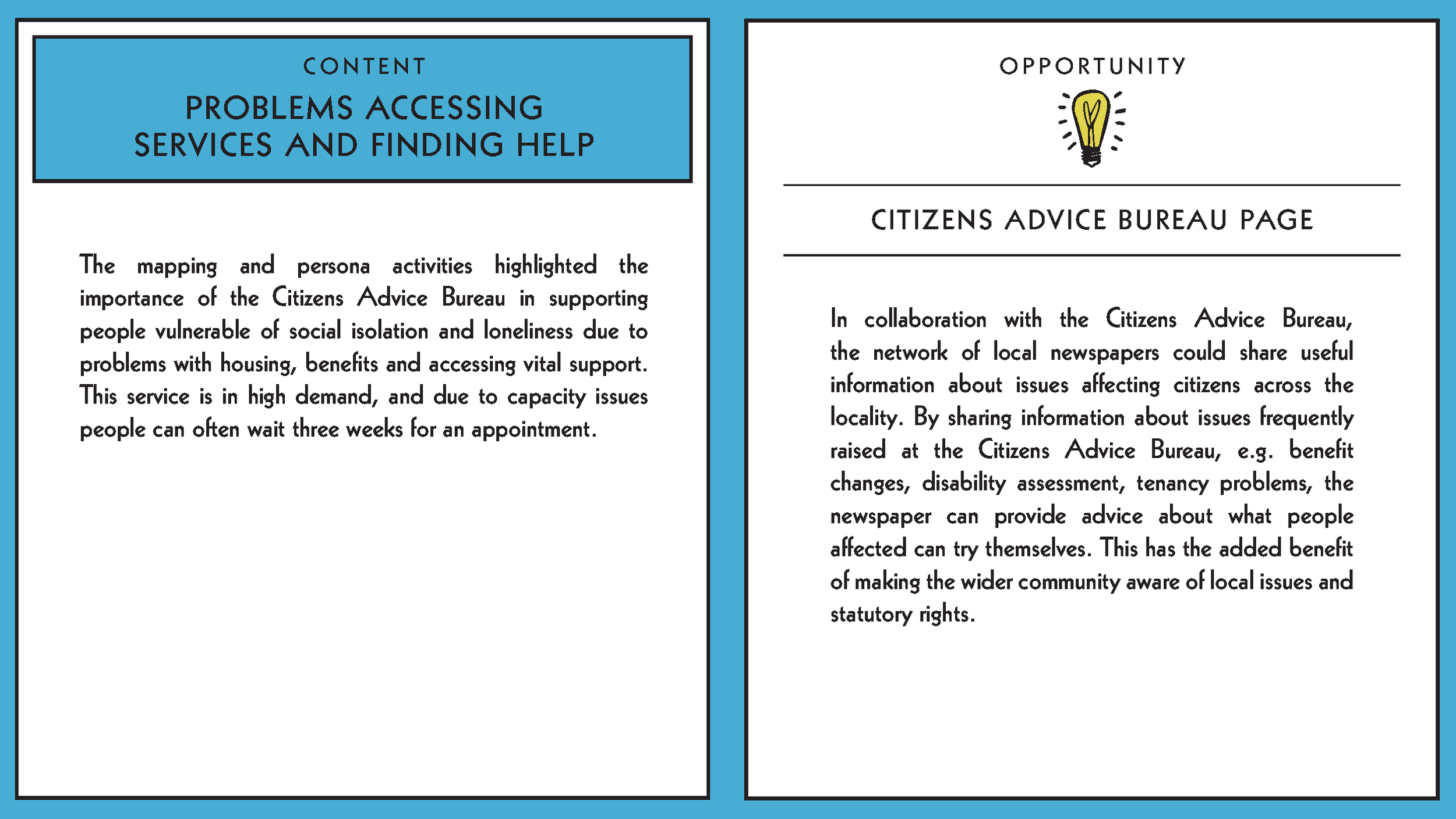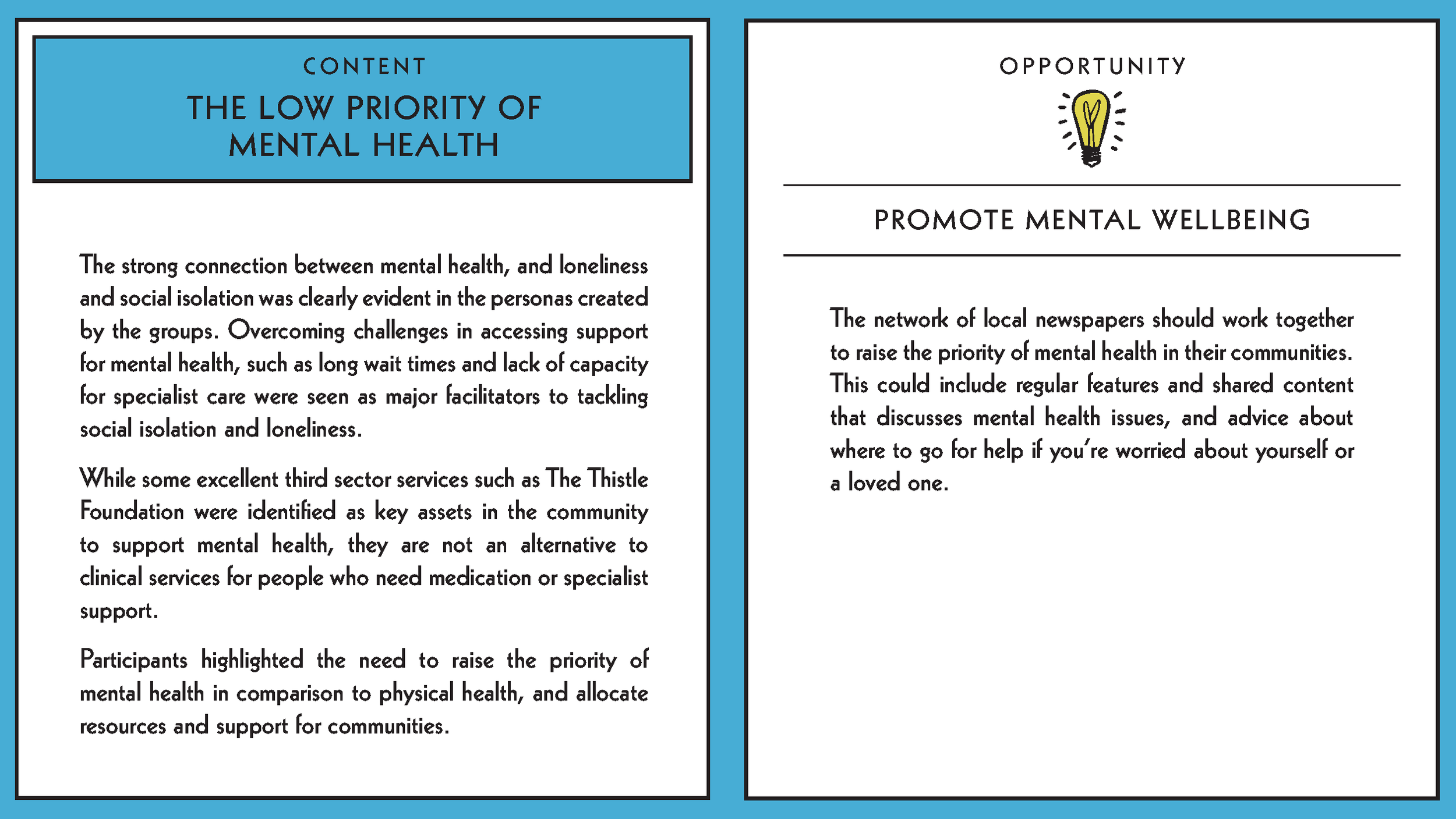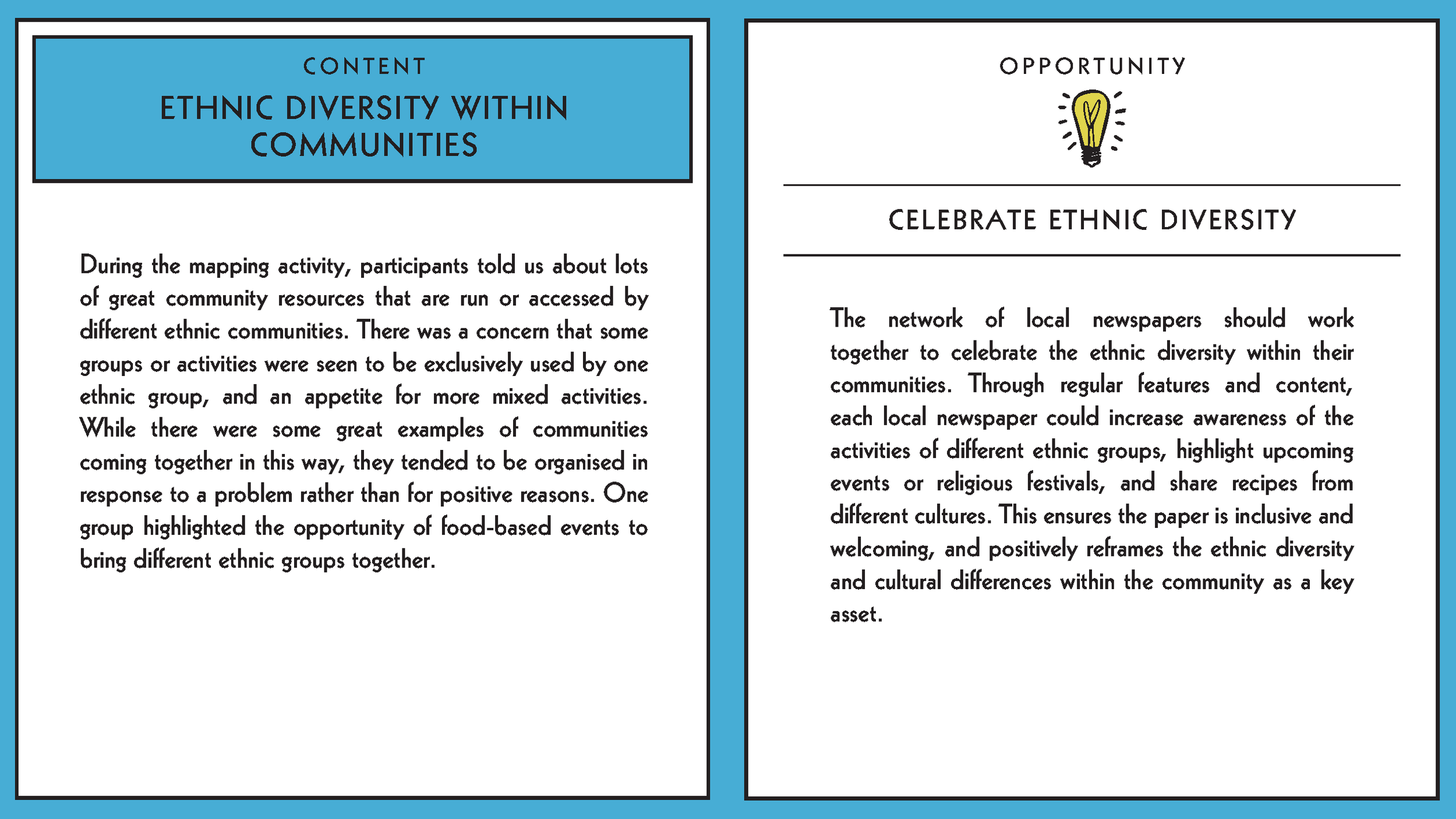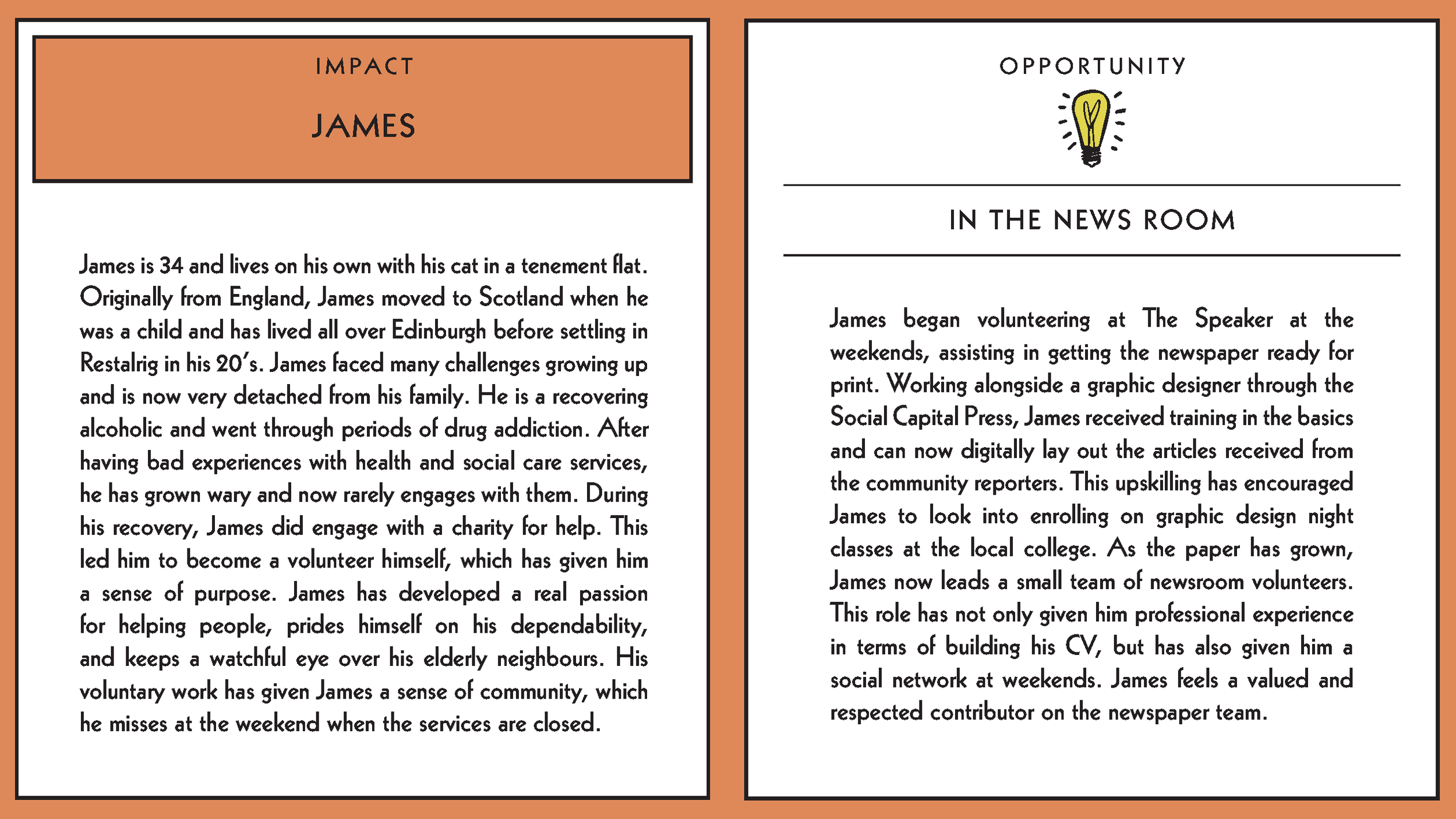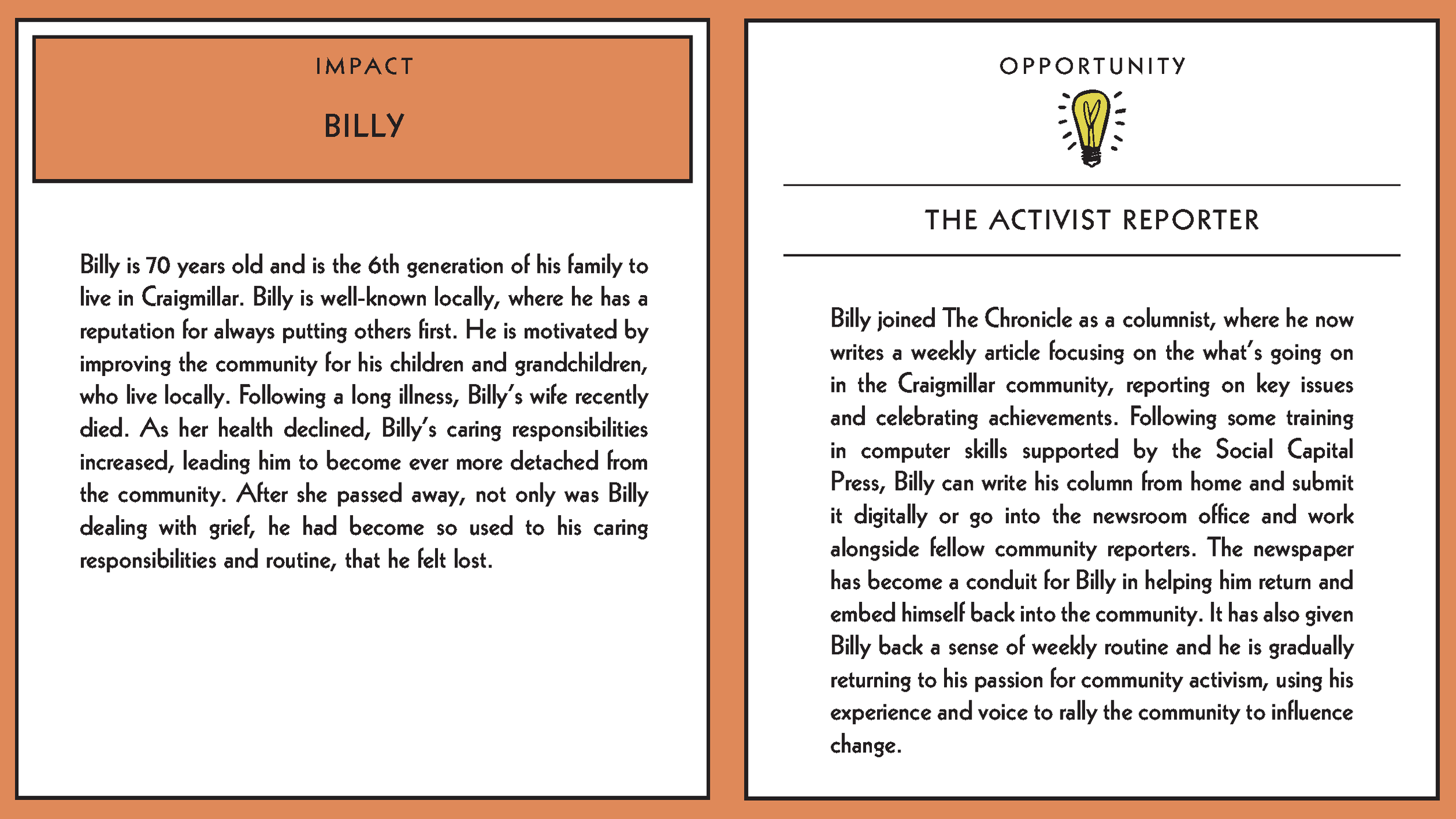Mapping Social Connection
in North East EDINBURGH: Person and Place
INTRODUCTION
In this project, we responded to a challenge set by the Locality Manager of North East (NE) Edinburgh at Edinburgh Health and Social Care Partnership, to explore how they might engage with their partners, staff and citizens living and working locally, around the topics of social isolation and loneliness. In an exploratory workshop with stakeholders and citizens, we used bespoke design tools and activities based on the board game 'monopoly' both to understand the local context, and to generate insight into how to engage and support the community in tackling social isolation and loneliness.
The aims of the project and the approach we used is described, and findings are presented as follows:
Area summaries describing the four communities within NE Edinburgh which were the focus of discussions;
Key insights about the topic of social isolation and loneliness and opportunities for engagement and support;
General principles for engagement to guide future work of the NE Locality Team.
Finally, the tools and supporting materials are available for download for the team to use and adapt for further engagement sessions with NE Edinburgh Locality constituents.
AIMS
The project aimed to understand the current context, identify gaps in knowledge and services, and identify opportunities for engagement with stakeholders and citizens. In addition, the project specifically aimed to address the following question:
“How do we engage constituents within North East Edinburgh and how do we engage people in co-design around the topic of Social Isolation?”
Key objectives:
Create a shared understanding of social isolation and its relationship to loneliness in North East (NE) Locality from the perspective of people and place;
Explore, validate and develop a set of visual ‘assets’ that communicate this shared understanding and engage stakeholders;
Identify opportunities for collaborative working, engagement and innovation in NE Locality.
The project is intended to support key outcomes and actions of the NE Locality Improvement Plan – Health and Wellbeing, 2017 – 2022.
APPROACH
A workshop was held with stakeholders from the NE Locality, including people from a mix of statutory, third sector and community based organisations working to reduce social isolation and loneliness, including representation from services who support people across all ages. Participants also included people with lived experience of loneliness or social isolation who were service users of local organisations.
The design tool created for the workshop was built around the concept of a a monopoly board, but explored social capital rather than financial.
Activity one: mapping place
The first activity invited participants to map existing community resources in four areas of the NE Locality and identify areas of opportunity resulting from gaps in services. The activity aimed to capture what the existing community resources offered people who are socially isolated and how place-centred support could be promoted and nurtured through building connections.
Activity two: mapping people
The second activity aimed to generate understanding of groups who are currently socially isolated or at risk of becoming socially isolated. The activity supported discussion around the relationship between social isolation and loneliness and ways in which to identify vulnerable people and groups. This discussion was embodied using a ‘persona’ template, which supported the group to describe an individual and explore their different relationships with family and friends, community and the State, and some of the challenges and facilitators of engagement at each level. In addition, the activity explored the needs and barriers of people who are socially isolated that prevent them from accessing services.
Activity three: community connections
The final activity involved participants bringing together the different Locality area place maps and personas to create the full monopoly board and 'play' monopoly to understand how individuals move around the board and connect with people and places in the Locality who can support them to feel more connected. The activity aimed to identify future ways of collaborating to reduce social isolation and loneliness in NE Locality by reflecting on the person and place centred maps to identify priority areas.
A deck of ‘Chance cards’ and 'Community Chest cards' were created to prompt discussion around successful ideas for tackling social isolation and loneliness from other areas and contexts, and community resources that are not places (e.g. events, free transport, online resources and helplines) respectively.
The four corners of the board were added to identify what was needed to bring all this together and which ideas, resources or initiatives can be used to support the places and people in NE Locality to connect.
FINDINGS
AREA SUMMARIES
The outputs of the mapping activity have been summarised to provide 'the headlines' from each of the areas we focused on during the workshop. Across the different areas we learned about common challenges, such as the impact of gentrification and regeneration on the local sense of identity, and the availability of affordable housing and local shops. We heard about the role local businesses play in supporting people who might be lonely or socially isolated, and how local shops can struggle to compete with supermarkets. Transport between different parts of NE Locality is a challenge, and the cost and location of services can be a barrier to engagement.
Scroll through the slideshow below, or download a PDF version.
KEY INSIGHTS AND OPPORTUNITIES
The key actionable insights (including what works, gaps, ideas and challenges) from the workshop are presented and illustrated using a design concept for a network of local newspapers. This concept is used as an example to show one possible way the insights presented could be translated into a way of engaging with citizens in NE Locality. It is not intended as a proposal, but more as a way of illustrating how the locality could practically respond to the insights.
The insights are presented on the left-hand page, the right-hand page proposes how this insight could be translated into an opportunity to engage and build community through the network of community newspapers. The insights and opportunities are organised into colour coded sections: rationale for the network of local newspapers (pink), format (green) and content (blue) ideas and finally potential impact (orange) for people who get involved. Scroll through the slideshow below, or download a PDF version.
PRINCIPLES FOR ENGAGEMENT
Reflecting on the key insights shared by participants about what works when engaging around the subject of social isolation and loneliness, we have identified a number of key principles for engagement. These are intended to guide any future work by the NE Locality team, but may also be of interest to the wider civic, academic, business and national third sector organisations who seek to support communities in NE Edinburgh.
1. community-led
There was a clear message from participants that statutory organisations and funders should be led by what the community determine is needed at a local level. Participants from community organisations expressed frustration that they often have to design projects and initiatives to suit the specific agenda of funders rather than the needs of their community.
2. CELEBRATE DIVERSITY AND IDENTITY
We learned about the many 'villages' which make up the diverse areas within NE locality. While this might be seen as a challenge for engagement across the locality, the distinct local identities should be viewed as an asset, and any locality wide engagement should celebrate and acknowledge this.
3. SUSTAIN WHAT WORKS
Participants highlighted several vital community-led projects that had been unable to continue due to changes in funding. There is a need to sustain what is clearly working at a local level, to preserve these assets for the community.
4. ENGAGE AROUND THE LOCAL ISSUES PEOPLE CARE ABOUT
Participants shared examples of where the community had successfully come together to respond to a local issue. In these instances the community achieved their desired goal, and it was highlighted that affecting change is very effective in building community. This suggests that to engage the community we need to understand the local issues that are important to them. This also highlights the importance of demonstrating how their opinions and ideas have been listened to and acted upon.
5. WELCOMING PLACES
Ensuring the places where engagements take place are accessible, welcoming and local helps to remove possible barriers to engagement. This might mean going to where people are, working in partnership with community spaces, visiting people door-to-door and using popular social media platforms.
6. HARNESS COMMUNITY KINDNESS
Participants highlighted that the people in their communities are inherently kind, empathetic and want to help others. Initiatives should be built on this asset, enabling people to support others in their community who may be socially isolated or lonely.
7. CROSS THE DIGITAL DIVIDE
There was a clear message that digital services often exclude the most vulnerable people in the community, who are most likely to be at risk of social isolation and loneliness. This raises the importance of ensuring any engagement uses multiple different formats. By embracing different forms of communication we can ensure people aren’t excluded from the organisations and people who can help.
8. PARTNERSHIP WORKING
Participants highly valued partnership working, for example one group highlighted the proposed Castlebrae High School and Bio quarter collaboration to create a Centre for Scientific Excellence as empowering for the young people and businesses in the community. They wished to see more innovative collaborations of this kind.
TOOLS AND DOWNLOADS (Hyperlinks)
The tools are available to download and use in further workshops. You can follow the order of workshop activities described above, or adapt the activities to suit your participants and aims. If you use the tools, we would appreciate some feedback on how you used them, how they worked in your session and any ideas for improving them, using the form below.
The key insights and opportunities slide deck can also be printed as individual cards for discussion:
A PDF version of the web-based report is available here:
further information
For further information about the project, please get in touch:
Gemma Teal, g.teal@gsa.ac.uk
Dr. Tara French, t.french@gsa.ac.uk
Dr. Marianne McAra, m.mcara@gsa.ac.uk






